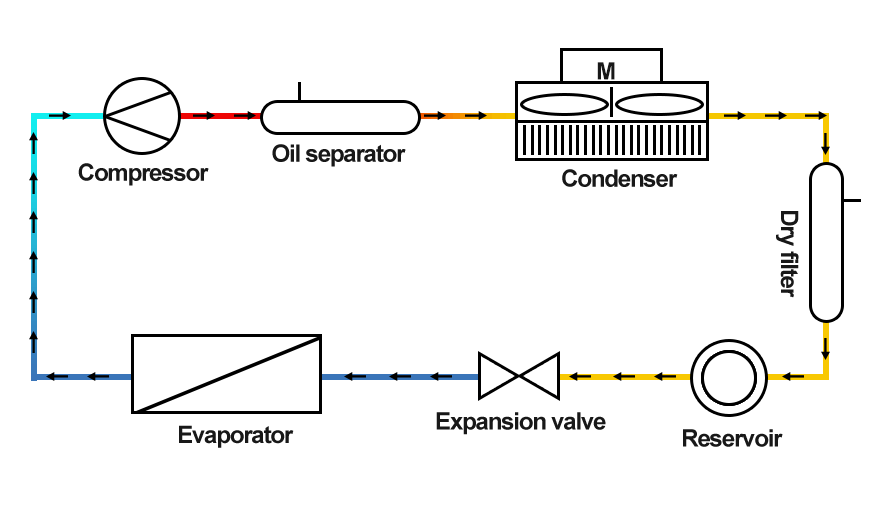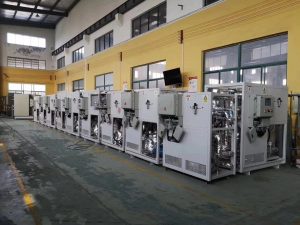Is the low temperature cooling unit – 120 degrees cooling effect reliable?
LNEYA specializes in the production of single-fluid cryogenic cooling units, the cooling temperature range is from -150 degrees to -5 degrees, which can meet different cooling temperature requirements. The products are widely used in low temperature reaction fields in chemical, pharmaceutical, biochemical and other industries, with fast cooling speed, safety and reliability. The product uses a 7-inch color touch screen to display input and record temperature curves. The entire system is a fully closed system, and there is no water absorption during low temperature operation, ensuring the purity of the cold heat transfer medium, preventing ice crystals, and improving the life of the heat transfer fluid.

FEATURES:
1. Temperature adjustment range: -150 degrees to -5 degrees, temperature control accuracy ± 1 ℃ refrigeration;
2. Adopt cascade refrigeration, cooling capacity: 1 to 1000KW are available;
3. With RS485 and R232 interfaces, it can communicate with the computer, so as to accept the setting and control of the computer, and transmit the measured temperature to the computer;
4. Optional imported heat transfer fluid;
5. The liquid storage tank and pipeline are sealed and pressurized to prevent the refrigerant from volatilizing, dew condensation and freezing, and have liquid level indication;
6. For small load heating, the hot gas bypass of the compressor can be used to heat the load;
7. Multiple alarm protections: water cutoff, high water temperature, circulation pump failure, compressor overheating, high pressure, overcurrent, phase loss, phase continuity, etc.;
8. Heat dissipation method: air cooling and water cooling are optional, and the air cooling condenser can be placed outdoors.
The application of the refrigerant carried by the cryogenic chiller:
1. The load volume of the general user is relatively large. If the load needs to have a uniform temperature, it must be filled with refrigerant. However, at normal temperature, a large amount of low-temperature refrigerant will become gas, and the volume and pressure of the gas will be huge, and the equipment itself will not be able to meet it;
2. The load on the user site is far away from the refrigeration room, and the load area is usually a clean, explosion-proof and quiet area. The refrigerant circulation system can separate the cryogenic unit and the load area, making the whole system more reliable.
3. Usually, the cooling capacity is to cool the material in the load through the heat exchange coil in the load. Once the heat exchange coil leaks, it may cause pollution to the material, and the refrigerant system usually uses a solvent with the material. substance, so even if it leaks, the possibility of contamination can be completely avoided;
4. The refrigerant is also a carrier for storing cold energy. When the load changes greatly, it can be adjusted by the refrigerant. This is conducive to temperature control and energy saving. Generally speaking, the greater the load fluctuation, the greater the amount of refrigerant required;
5. The heat exchange efficiency is higher than that of liquid nitrogen. The liquid nitrogen uses the latent heat of evaporation to release the cooling capacity. After the liquid nitrogen absorbs heat, it becomes a gaseous state. The gas-liquid two-phase mixing state occurs in the coil, resulting in a large air resistance and a sharp decrease in the flow rate, so that the liquid nitrogen cannot be completely combined with the liquid nitrogen. The tube wall is in contact, and the heat exchange efficiency is greatly reduced;
6. The refrigerant generally uses Glacier refrigerant (freezing point -118 ℃) dichloromethane (boiling point 40 ℃, freezing point -95 ℃), alcohol (boiling point 78 ℃, freezing point -114 ℃), dichlorofluoroethane (boiling point 32 ℃) , freezing point -103 ℃), trifluorodichloroethane (boiling point 28.7 ℃, freezing point -107 ℃), difluorochloroethane (boiling point -10 ℃, freezing point -131 ℃), non-toxic, non-flammable, environmentally friendly, Inexpensive. The circulation of the refrigerant adopts a magnetic circulation pump to reduce the influence of pollution and low temperature on the bearing seal.
관련 권장 사항
-
What is the reason why the industrial chiller system cannot be cooled
1292Let the LNEYA technical engineer explainthe reason for everyone: The first one: The chiller system fails tolower the temperature during the first use, or there is a problem with theinstallation of the industrial water chiller, cooling tower, ...
세부 정보 보기 -
LNEYA semiconductor refrigeration unit common fault description
1431If a high-voltage alarm occurs in the semiconductor refrigeration unit, it is necessary to check whether the external piping is blocked or dirty. Clean and remove in time. If it is an air-cooled semiconductor refrigeration device, it is necessary ...
세부 정보 보기 -
Working principle of refrigeration and heating thermostat for chemical industry
1046In the selection process of the special refrigeration and heating thermostat for chemical industry, the heating power and the pressure and flow rate of the heat transfer medium are also factors to be considered. Different raw materials have differ...
세부 정보 보기 -
Vocs 흡착 장비 냉장 온도 제어 지침
1133환경 보호 요구 사항이 지속적으로 개선됨에 따라 각 공장은 생산 과정에서 발생하는 vocs 가스 처리에도 집중하고 있습니다. LNEYA 보컬 흡착 장비는 다양한 보컬 가스를 처리 할 수 있습니다. 그래서 당신은 얼마나 알고 있습니까?
세부 정보 보기
 LNEYA 산업용 냉각기 제조업체 공급 업체
LNEYA 산업용 냉각기 제조업체 공급 업체













